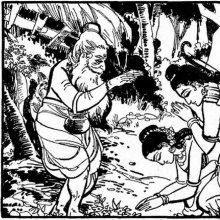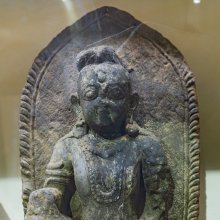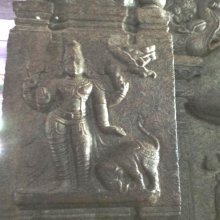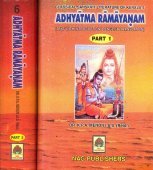Agastya, Āgastya: 33 definitions
Introduction:
Agastya means something in Buddhism, Pali, Hinduism, Sanskrit, the history of ancient India, biology. If you want to know the exact meaning, history, etymology or English translation of this term then check out the descriptions on this page. Add your comment or reference to a book if you want to contribute to this summary article.
Images (photo gallery)
In Hinduism
Purana and Itihasa (epic history)
Source: Wisdom Library: Bhavishya-puranaAgastya (अगस्त्य):—The consequences of using various flowers in worship, (e.g. agastya flowers) leads to success, according to the Bhaviṣya-purāṇa (brahmaparva, 197:1-11)
Source: archive.org: Puranic EncyclopediaAgastya (अगस्त्य).—Genealogy. Descended from Viṣṇu in this order Brahmā-Marīci-Kaśyapa-Sūrya-Agastya. (See full article at Story of Agastya from the Puranic encyclopaedia by Vettam Mani)
Source: archive.org: Shiva Purana - English Translation1) Agastya (अगस्त्य) is the name of a plant which is used in the worship of Śiva, according to the Śivapurāṇa 2.1.14:—“[...] a Dhattūra plant with red stem (raktadaṇḍa) is specially auspicious for worship. A worshipper using Agastya flowers (kusuma) will earn great fame”.
2) Agastya (अगस्त्य) is a Muni (Sage) who once attended a great sacrifice by Dakṣa, according to the Śivapurāṇa 2.2.27. Accordingly as Brahmā narrated to Nārada:—“[...] once a great sacrifice was started by Dakṣa, O sage. To partake in that sacrifice, the celestial and terrestrial sages and devas were invited by Śiva and they reached the place being deluded by Śiva’s Māyā. [Agastya, ...] and many others along with their sons and wives arrived at the sacrifice of Dakṣa—my son”.
Source: Cologne Digital Sanskrit Dictionaries: The Purana Index1a) Agastya (अगस्त्य).—A son of Pulastya and Havirbhū: he was Dahra-agni in his previous birth.*
- * Bhāgavata-purāṇa, IV, 1. 36.
1b) A contemporary of Kṛṣṇa and Rāma; and a resident of Mount Malaya. Visited by Balarāma.1 Came to Syamantapañcaka to see Kṛṣṇa.2 Called on Parīkṣit practising prāyopaveśa.3
1c) Married the first born daughter of King Malayadhvaja Pāṇḍya, and had a son Dṛḍhācyuta.1 Cursed the Pāṇḍyan king Indradyumna to become an elephant.2
1d) The constellation (Canopus) that moves fast above Dhruvamaṇḍala.*
- * Brahmāṇḍa-purāṇa II. 21. 101; Vāyu-purāṇa 50, 155.
1e) A hill of that name.*
- * Matsya-purāṇa 124. 97.
1f) Born of garbha; born later as Dattāli;1 (Dattoli). residence (bhavana) at Mahāmalaya;2 relation of, to Potṛyaṇa;3 Udayantaka mountain brought by; and his wife.4
- 1) Vāyu-purāṇa 28. 22; Viṣṇu-purāṇa I, 10. 9.
- 2) Vāyu-purāṇa 48. 23.
- 3) Vāyu-purāṇa 59. 93, 208.
- 4) Vāyu-purāṇa 108. 44, 53.
1g) A group of Rākṣasas.*
- * Brahmāṇḍa-purāṇa III. 7. 162.
2) Āgastya (आगस्त्य).—The Brahmarākṣasas—a clan moving about in the night;1 of Surabhi forest;2 summoned Kauberaka to live at Hariśṛṅga.3
- 1) Brahmāṇḍa-purāṇa III. 8. 59 and 62; Vāyu-purāṇa 69. 195-6.
- 2) Matsya-purāṇa 121. 62.
- 3) Vāyu-purāṇa 47. 60-1.
Agastya (अगस्त्य) refers to the name of a Tīrtha (pilgrim’s destination) mentioned in the Mahābhārata (cf. III.86.10). Note: The Mahābhārata (mentioning Agastya) is a Sanskrit epic poem consisting of 100,000 ślokas (metrical verses) and is over 2000 years old.
Agastya is also mentioned in the Mahābhārata (cf. IV.20.11) and represents one of the many proper names used for people and places.
Source: Shodhganga: The saurapurana - a critical studyAgastya (अगस्त्य) (also known as Datta) is the son of Pulastya and Prīti: one of the twenty-four daughters of Dakṣa and Prasūti, according to the Vaṃśa (‘genealogical description’) of the 10th century Saurapurāṇa: one of the various Upapurāṇas depicting Śaivism.—Accordingly, Ākūti was married to Ruci and Prasūti to Dakṣa. Dakṣa produced in Prasūti twenty-four daughters. [...] [Prīti was given to Pulastya.] Pulastya and Prīti had a son named Datta who was well known as Agastya.

The Purana (पुराण, purāṇas) refers to Sanskrit literature preserving ancient India’s vast cultural history, including historical legends, religious ceremonies, various arts and sciences. The eighteen mahapuranas total over 400,000 shlokas (metrical couplets) and date to at least several centuries BCE.
Ayurveda (science of life)
Cikitsa (natural therapy and treatment for medical conditions)
Source: Wisdom Library: Ayurveda: CikitsaAgastya (अगस्त्य) is a Sanskrit word referring to Sesbania grandiflora, a small tree from the Fabaceae (legume) family of flowering plants. It is used throughout Ayurvedic literature such as the Caraka-saṃhitā and the Suśruta-saṃhitā. It is also known as Agasti. In English, the plant is known as the “vegetable hummingbird”, “agati” or the “humminbird tree”. It has many botanical synonyms, among which: Aeschynomene grandiflora, Agati grandiflora, Coronilla grandiflora and Emerus grandiflorus.
This plant (Sesbania grandiflora) is also idintified with Muni, a medicinal plant used for the treatment of all major fevers (jvara), as described in the Jvaracikitsā (or “the treatment of fever”) which forms the first chapter of the Sanskrit work called Mādhavacikitsā.
Unclassified Ayurveda definitions
Source: archive.org: Vagbhata’s Ashtanga Hridaya Samhita (first 5 chapters)Agastya (अगस्त्य) refers to star Canopus, mentioned in verse 3.52 of the Aṣṭāṅgahṛdayasaṃhitā (Sūtrasthāna) by Vāgbhaṭa.—Accordingly, “[...] when hungry, one shall turn to bitter, sweet, astringent, and light food, [...]; to water (that is) heated by the beams of the hot-rayed one (and) cooled by the beams of the cold-rayed one, and this thoroughly day and night; (that is) detoxicated by the (heliacal) rising of Canopus [viz., Agastya], pure, called ‘swan-water’, devoid of dirt, (and) destructive of dirt”.
Note: Agastya, also written Agasti, has been reproduced here and in IV.3.131 by the Sanskrit word Ri-ṣi (for rsi), Agastya being evidently taken for the Indian sage par excellence. The proper Tibetan correspondent, which is given as Ri-byi in Mahāvyutpatti 3457, occurs in IV.6.54 and VI.35.64, but only as the reading of CD, while NP have respectively Ri-ṣi and Ri-yi instead.
The regent of Canopus is said to be the sage Agastya, from whom the star takes its name in Sanskrit. The story of Agastya cleaning the waters is also alluded to in VI.35.63 sq. The topic recurs in other medical texts (Carakasaṃhitā 16.46; As. I 4 ~ I p. 27b7 & VI 40 ~ III p. 328a20) as well as in classical poetry (Raghuvaṃśa XIII 36). Its origin we were unable to trace.

Āyurveda (आयुर्वेद, ayurveda) is a branch of Indian science dealing with medicine, herbalism, taxology, anatomy, surgery, alchemy and related topics. Traditional practice of Āyurveda in ancient India dates back to at least the first millenium BC. Literature is commonly written in Sanskrit using various poetic metres.
Shaivism (Shaiva philosophy)
Source: Wisdom Library: ŚaivismAgastya is the name of one of the eighteen Siddhars mentioned in the Abhidāna-cintāmaṇi, a 12th century lexicon by Hemacandra. The Siddhars refers to ancient intellectuals of Tamil Nadu and are the teachers of Siddha medicine: an ancient practice of South-India claiming to over 8,000 years old.
According to tradition, Nandi and Agastya learnt the Siddha system of medicine and Śivayoga from Śiva, and imparted it to a number of disciples (eg., Agastya). These Siddhars are united by their philosophy, accepting the human body as the microcosm of the universe, and seeing the human evolution as the ultimate accomplishment of the regenerative power of the Universe.
Source: DSpace at Pondicherry: Siddha Cult in Tamilnadu (shaivism)Agastya.—In the Tamil Siddha tradition, Agastya (Agattiyar in Tamil) is celebrated as the pioneer of the Siddha cult as well as father of a Tamil School of medicine. Many of the Tamil Siddhas trace their origin to Agastya. Invariably, there exist many local traditions and fabulous myths on him.
Maṇimekalai also tells about the miraculous birth of the sage and his relation to Vasiṣṭha. The first reference to Agastya as the “Father of Tamil” and the first Tamil grammarian is found in Nakkīrar’s commentary to Iraiyanār’s Akapporul (8th century C.E).
According to another tradition, Agastya married Lopamudrā and had a son named Sāgaren. He led the first colony of Brahmans from the north and settled in southern India under the auspices of Kulasekara Pāṇḍya, the founder of Pāṇḍyan dynasty of Madurai.

Shaiva (शैव, śaiva) or Shaivism (śaivism) represents a tradition of Hinduism worshiping Shiva as the supreme being. Closely related to Shaktism, Shaiva literature includes a range of scriptures, including Tantras, while the root of this tradition may be traced back to the ancient Vedas.
Vyakarana (Sanskrit grammar)
Source: Wikisource: A dictionary of Sanskrit grammarĀgastya (आगस्त्य).—Name of an ancient writer of Vedic grammar and Prātiśākhya works; cf. R. Pr.I.2.

Vyakarana (व्याकरण, vyākaraṇa) refers to Sanskrit grammar and represents one of the six additional sciences (vedanga) to be studied along with the Vedas. Vyakarana concerns itself with the rules of Sanskrit grammar and linguistic analysis in order to establish the correct context of words and sentences.
Natyashastra (theatrics and dramaturgy)
Source: Wisdom Library: Nāṭya-śāstraAgastya (अगस्त्य) is the name of a sage who was in the company of Bharata when he recited the Nāṭyaveda them, according to the Nāṭyaśāstra chapter 35. Accordingly, they asked the following questions, “O the best Brahmin (lit. the bull of the twice-born), tell us about the character of the god who appears in the Preliminaries (pūrvaraṅga). Why is the sound [of musical instruments] applied there? What purpose does it serve when applied? What god is pleased with this, and what does he do on being pleased? Why does the Director being himself clean, perform ablution again on the stage? How, O sir, the drama has come (lit. dropped) down to the earth from heaven? Why have your descendants come to be known as Śūdras?”.

Natyashastra (नाट्यशास्त्र, nāṭyaśāstra) refers to both the ancient Indian tradition (shastra) of performing arts, (natya—theatrics, drama, dance, music), as well as the name of a Sanskrit work dealing with these subjects. It also teaches the rules for composing Dramatic plays (nataka), construction and performance of Theater, and Poetic works (kavya).
Pancaratra (worship of Nārāyaṇa)
Source: archive.org: Isvara Samhita Vol 5Āgastya (आगस्त्य) is the name of a plant which is considered a vegetable fit for use in oblation offerings, according to verse 25.128b-134 of the 8th-century Īśvarasaṃhitā. Accordingly, “... they [eg., Āgastya] are to be cut with a knife or sickle uttering vīryanantra, shall notice the (presence of the worms), insects and wash them (vegetables) many times, with water. They are to be kept as before, in cooking vessels, either alone or mixed up with each other with salt, pepper, mustards, jīraka, leaves of śrīparṇī, water, waters of the coconut, their fruits and grinded with honey mixed up with ghee, together with pulses, black gram, neem and varieties of green gram with soups. Kinds of green gram and others without soup but with salt and others”.
Source: Shodhganga: Iconographical representations of Śiva (pancaratra)Agastya (अगस्त्य) or Agastyasaṃhitā is the name of a Vaiṣṇava Āgama scripture, classified as a sāttvika type of the Muniprokta group of Pāñcarātra Āgamas. The vaiṣṇavāgamas represent one of the three classes of āgamas (traditionally communicated wisdom).—Texts of the Pāñcara Āgamas are divided in to two sects. It is believed that Lord Vāsudeva revealed the first group of texts which are called Divya and the next group is called Muniprokta which are further divided in to three viz. a. Sāttvika (e.g., Agastya-saṃhitā). b. Rājasa. c. Tāmasa.

Pancaratra (पाञ्चरात्र, pāñcarātra) represents a tradition of Hinduism where Narayana is revered and worshipped. Closeley related to Vaishnavism, the Pancaratra literature includes various Agamas and tantras incorporating many Vaishnava philosophies.
Vaishnavism (Vaishava dharma)
Source: Pure Bhakti: Brhad BhagavatamrtamAgastya (अगस्त्य) refers to:—A great sage, the son of Mitra and Varuṇa, who was born in a water pot. He composed Vedic hymns, drank the entire ocean to help the demigods defeat the dānavas, and obliged the Vindhya mountain range to bow down before him. Agastya also refers to the mind. (cf. Glossary page from Śrī Bṛhad-bhāgavatāmṛta).

Vaishnava (वैष्णव, vaiṣṇava) or vaishnavism (vaiṣṇavism) represents a tradition of Hinduism worshipping Vishnu as the supreme Lord. Similar to the Shaktism and Shaivism traditions, Vaishnavism also developed as an individual movement, famous for its exposition of the dashavatara (‘ten avatars of Vishnu’).
Jyotisha (astronomy and astrology)
Source: Wisdom Library: Brihat Samhita by VarahamihiraAgastya (अगस्त्य) (or “Canopus”) refers to a star sacred to Agastya who is said to have drunk off the ocean and suppressed the heights of the Vindhya mountains, according to the Bṛhatsaṃhitā (chapter 12), an encyclopedic Sanskrit work written by Varāhamihira mainly focusing on the science of ancient Indian astronomy astronomy (Jyotiṣa).—Accordingly, “The mighty ocean whose waters were swallowed by Agastya, exhibited gems that eclipsed the splendour of the crowns of the Devas and rocks broken by the action of the sharks on them and thus presented an appearance beautiful, though without water. It also exhibited hills with trees, corals and gems and the scene was rendered picturesque by serpents that issued from the rocks. [...]”.

Jyotisha (ज्योतिष, jyotiṣa or jyotish) refers to ‘astronomy’ or “Vedic astrology” and represents the fifth of the six Vedangas (additional sciences to be studied along with the Vedas). Jyotisha concerns itself with the study and prediction of the movements of celestial bodies, in order to calculate the auspicious time for rituals and ceremonies.
General definition (in Hinduism)
Source: Google Books: 101 Mystics of IndiaSage Agastya, who was dwarfish in appearancem is considered the doyen of Tamil mystics and the father of the Tamil language. He is to the Tamil language what Panini was to Sanskrit. Agastya is famous for teaching the “Āditya Hṛdaya” mantra to Sri Rama on the eve of his battle with the demon Ravana. Rama is believed to have won victory vecause of the power of the prayer to the Sun taught by Agastya.
Kāryasiddhimalai literally means “garland (of songs) which ensures success in undertakings”. Other works attributed to Agastya are:
- Agastya Gita (in the Varahapurana)
- Agastya Samhita (in Skandapurana)
- Siva Samhita (in Bhaskara Samhita)
-
Dvaida Nirnaya Tantra
According to legend, the sage Agastya is an incarnation of Agni. Agni and Vayu had been cursed by Indra for insubordination to be born as mortals. Vayu was born as Vasishta (this account is different from the popular one where Vasishta is a wish-born son of Brahma). According to this curse, Agastya was born as the son of MitraVaruna Rishi (this is different from the dual Mitra-Varuna mentioned in the Rig Veda) and the Apsara Urvashi. Among the many epithets of Agastya are KumbhaSambhava (born in a pot) and MitraVaruni (son of MitraVaruna). From an early age he displayed an aptitude for the scriptures and spirituality.
He married Lopamudra, the daughter of the king of Vidharba. He also had another wife named Kaveri, who was the daughter of a sage named Kavera.
He is also famous for his curses. He cursed Nahusha who had insulted him, to be born as a giant python. Bheema was instrumental in releasing Nahusha from the curse. He had also cursed a king named Indradhyumna to be born as an elephant, for the King busy with his prayer, was late in receiving the sage.
He is also famed for drinking the ocean dry.
Source: WikiPedia: HinduismAgastya (अगस्त्य): A great sage whose life-story the Pandavas learnt while on pilgrimage to holy places, his wife Lopamudra was equally a great sage in her own right.
In Buddhism
Mahayana (major branch of Buddhism)
Source: De Gruyter: A Buddhist Ritual Manual on AgricultureAgastya (अगस्त्य) is the name of a Ṛṣi (to be painted on a flagstaff as part of a pacification ritual), according to the Vajratuṇḍasamayakalparāja, an ancient Buddhist ritual manual on agriculture from the 5th-century (or earlier), containing various instructions for the Sangha to provide agriculture-related services to laypeople including rain-making, weather control and crop protection.—Accordingly, [As the Bhagavān teaches a pacification ritual]: “A pacification rite should be performed at four places in the field. [...] One should paint the glorious Buddha, Agastya Ṛṣi and Vajradhara and it should be mounted at the top of a flagstaff in an elevated place. Flowers and incense of offering should be given. A stake made of khadira wood measuring eight aṅgulas should be [enchanted] a thousand times and driven into the ground on the top of a dwelling. [...]”.

Mahayana (महायान, mahāyāna) is a major branch of Buddhism focusing on the path of a Bodhisattva (spiritual aspirants/ enlightened beings). Extant literature is vast and primarely composed in the Sanskrit language. There are many sūtras of which some of the earliest are the various Prajñāpāramitā sūtras.
India history and geography
Source: Heidelberg: Glory of the Tiruvanantapuram Padmanabhasvami TempleAgastya (अगस्त्य) is the name of an ancient Sage mentioned in the Anantaśayanakṣetramāhātmya, a text talking about the Thiruvananthapuram temple in eleven chapters, written before the 14th century and claiming to be part of the Brahmāṇḍapurāṇa.—The second chapter of the māhātmya describes sage Agastya’s arrival on the banks of the Tāmraparṇī river to help the Devas to restore the balance of the earth, which had become unbalanced by the great size of the crowd attending the marriage of Śiva and Pārvatī in the Himalāya mountains. Agastya, who feels that he might not be able to have the vision of Viṣṇu if he moved to the south, is told by Viṣṇu to perform penance on the banks of the Tāmraparṇī river; Viṣṇu assures him that he would appear before him while he is there.

The history of India traces the identification of countries, villages, towns and other regions of India, as well as mythology, zoology, royal dynasties, rulers, tribes, local festivities and traditions and regional languages. Ancient India enjoyed religious freedom and encourages the path of Dharma, a concept common to Buddhism, Hinduism, and Jainism.
Biology (plants and animals)
Source: Google Books: CRC World Dictionary (Regional names)Agastya in India is the name of a plant defined with Sesbania grandiflora in various botanical sources. This page contains potential references in Ayurveda, modern medicine, and other folk traditions or local practices It has the synonym Aeschynomene coccinea L.f. (among others).
Example references for further research on medicinal uses or toxicity (see latin names for full list):
· Species Plantarum (1753)
· Phytomorphology (1993)
· Species Plantarum
· Sylva Telluriana (1838)
· Supplementum Plantarum (1781)
· Species Plantarum.
If you are looking for specific details regarding Agastya, for example diet and recipes, side effects, extract dosage, pregnancy safety, chemical composition, health benefits, have a look at these references.

This sections includes definitions from the five kingdoms of living things: Animals, Plants, Fungi, Protists and Monera. It will include both the official binomial nomenclature (scientific names usually in Latin) as well as regional spellings and variants.
Languages of India and abroad
Sanskrit dictionary
Source: DDSA: The practical Sanskrit-English dictionaryAgastya (अगस्त्य).—
1) = अगस्ति (agasti) See above.
2) Name of Śiva.
Derivable forms: agastyaḥ (अगस्त्यः).
--- OR ---
Āgastya (आगस्त्य).—a. [agastyasyedam yañ yalopaḥ]
1) Southern (digbhāga). कौबेरदिग्भागमपास्य मार्गमागस्त्यमुष्णांशुरिवावतीर्णः (kauberadigbhāgamapāsya mārgamāgastyamuṣṇāṃśurivāvatīrṇaḥ) | Śi.
2) Pertaining to Āgastya; °आख्यानं सरः (ākhyānaṃ saraḥ) Mb.
3) Originating from the plant Agasti Grandiflorum.
-styaḥ, styī 1 The descendants of Agasti.
2) Persons of their race (gotra).
Source: Cologne Digital Sanskrit Dictionaries: Shabda-Sagara Sanskrit-English DictionaryAgastya (अगस्त्य).—m. (styaḥ) 1. The name of a saint. 2. A tree. 3. The star Canopus. See agasti.
Source: Cologne Digital Sanskrit Dictionaries: Benfey Sanskrit-English DictionaryĀgastya (आगस्त्य).—i. e. agasti + ya or agastya + a, adj. Reterring to Agasti, or Agastya, Mahābhārata 1. 442.
Source: Cologne Digital Sanskrit Dictionaries: Cappeller Sanskrit-English DictionaryAgastya (अगस्त्य).—[masculine] [Name] of a sage.
--- OR ---
Āgastya (आगस्त्य).—[adjective] relating to Agasti; [plural] Agasti's descendants.
Source: Cologne Digital Sanskrit Dictionaries: Aufrecht Catalogus CatalogorumAgastya (अगस्त्य) as mentioned in Aufrecht’s Catalogus Catalogorum:—Bālabhārata campū. Maṇiparīkṣā or Ratnaparīkṣā. Lakṣmīstotra. Lalitāsahasranāman. Śivasaṃhitā. Śivāṣṭaka. Sakalādhikāra.
Source: Cologne Digital Sanskrit Dictionaries: Monier-Williams Sanskrit-English Dictionary1) Agastya (अगस्त्य):—[from agasti] m. (3, 4) = agasti
2) [v.s. ...] Name of Śiva, [cf. Lexicographers, esp. such as amarasiṃha, halāyudha, hemacandra, etc.]
3) Āgastya (आगस्त्य):—[from āgastī] mf(stī)n. (cf. [Pāṇini 4-1, 114 and] [gana] saṃkāśādi) referring to the Ṛṣi Agastya or Agasti, [Mahābhārata] etc.
4) [v.s. ...] coming from the plant Agasti Grandiflorum, [Suśruta]
5) [v.s. ...] m. ([gana] gargādi q.v.) a descendant of Agasti, [Aitareya-āraṇyaka] etc.
6) [v.s. ...] m. [plural] (cf. [gana] kaṇvādi) the descendants of Agasti, [Mahābhārata iii, 971]
Source: Cologne Digital Sanskrit Dictionaries: Goldstücker Sanskrit-English DictionaryAgastya (अगस्त्य):—m.
(-styaḥ) 1) The name of a saint.
2) The star Canopus.
3) The name of a tree.
4) A name of Śiva. See agasti and the E. of this word.
Source: Cologne Digital Sanskrit Dictionaries: Yates Sanskrit-English DictionaryAgastya (अगस्त्य):—[a-gastya] (styaḥ) 1. m. A sage.
[Sanskrit to German]
Sanskrit, also spelled संस्कृतम् (saṃskṛtam), is an ancient language of India commonly seen as the grandmother of the Indo-European language family (even English!). Closely allied with Prakrit and Pali, Sanskrit is more exhaustive in both grammar and terms and has the most extensive collection of literature in the world, greatly surpassing its sister-languages Greek and Latin.
Kannada-English dictionary
Source: Alar: Kannada-English corpusAgastya (ಅಗಸ್ತ್ಯ):—
1) [noun] name of a sage-author of several Vedic hymns and Tamil grammar.
2) [noun] a super giant binary star in the constellation Carina, the second brightest star, with a magnitude of -0.86; Canopus.
3) [noun] the tree Sesbana (Agati grandiflora).
Kannada is a Dravidian language (as opposed to the Indo-European language family) mainly spoken in the southwestern region of India.
See also (Relevant definitions)
Partial matches: A.
Starts with (+17): Agastyabhavana, Agastyacara, Agastyachara, Agastyadarshana, Agastyagita, Agastyagrihaspatika, Agastyah, Agastyakumbhayoni, Agastyakunda, Agastyakusuma, Agastyakuta, Agastyamarga, Agastyanighantu, Agastyapada, Agastyaparvata, Agastyapushpa, Agastyar, Agastyarasa, Agastyargha, Agastyarghakatha.
Full-text (+648): Lopamudra, Agasti, Kumbhayoni, Vatapi, Kalashisuta, Agnimaruti, Lopamudrapati, Ghatayoni, Dahragni, Pitabdhi, Kaushitaki, Samudraculuka, Vindhyakuta, Vidarbhaja, Kumbhasambhava, Agastyagita, Agastyasamhita, Agastiya, Maitravaruni, Ghatodbhava.
Relevant text
Search found 119 books and stories containing Agastya, Āgastya, A-gastya; (plurals include: Agastyas, Āgastyas, gastyas). You can also click to the full overview containing English textual excerpts. Below are direct links for the most relevant articles:
Rig Veda (translation and commentary) (by H. H. Wilson)
The Markandeya Purana (by Frederick Eden Pargiter)
Canto CXV - Nābhāga’s exploits (continued)
Canto CXXVII - Avīkṣita’s exploits (continued)
Atharvaveda and Charaka Samhita (by Laxmi Maji)
5a. Worm infestation (Kṛmi) in the Atharvaveda < [Chapter 5 - Diseases and Remedies in Atharvaveda and Caraka-Saṃhitā]
Treatment of Apacit and Goitre < [Chapter 3 - Diseases and Remedial measures (described in Atharvaveda)]
Kāsa (bronchitis) according to Caraka < [Chapter 4 - Diseases and Remedial measures (described in Caraka-saṃhitā)]
Puranic encyclopaedia (by Vettam Mani)
Vastu-shastra (1): Canons of Architecture (by D. N. Shukla)
(v) Mānasāra (Summary) < [Chapter 5 - Study of Hindu Science of Architecture]
(iv) Other Ācāryas (chief preceptors) of Vastuśāstra < [Chapter 4 - An outline History of Hindu Architecture]
(iii) The Schools of Architecture and the Allocation of the Samarāṅguṇa < [Chapter 5 - Study of Hindu Science of Architecture]
The Agni Purana (by N. Gangadharan)
Related products
(+1 more products available)










